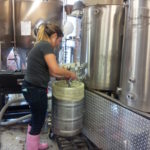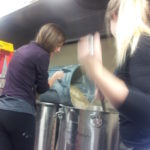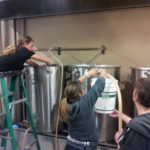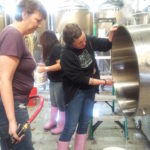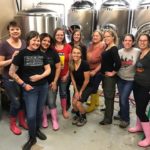A Strong Start
Earlier this year, I finally did something that’s been on my wish list since moving to our new home in Colorado. I organized a gathering of some of the women working in the beer industry locally. This led to a collaborate brewing project, which got some attention around town.
It started in late January when a dozen of us met up at a local brewery. We all work in different areas within the beer scene, from brewing to administration, distribution to media. Beyond just socializing, we discussed what we hoped to do as a group, including sharing expertise, organizing professional education events, and getting together to brew a collaboration beer. We later named ourselves the Ladies Lovibond Society, referring to an old color scale still used by maltsters.
In March, about 15 women woke before dawn to start brewing an early-American ale, based on a beer first brewed by Andrew Wales that friends of mine in Virginia recreated from historical documents, so it had a special significance to me. The recipe included traditional English-style malts and hops as well as lots of molasses.
We dubbed it The Riveter and released it in 6 breweries in April, with $1 of each pint sale donated to a local nonprofit that helps women and children affected by domestic violence. From what I’ve been told, sales were good. Many of the kegs kicked within a week, and a number of customers came out specifically for that beer. The final amount raised is still being calculated.
Due to it’s British history, the beer didn’t quite fit the style of the hoppier modern American strong ale. In fact, we ended up marketing it as an old ale.
For the most  part, I was pleased with the final product. The malt sweetness was prevalent in both the aroma and flavor with toast, molasses and faint caramel notes. Golden raisin and date characteristics also came through. Earthy hops and the stronger alcohol content helped to cut the sweetness so it wasn’t cloying. However, the sweetness was still off balance, the alcohol was a bit sharp, and it looked hazy. Were it homebrew, I would have allowed it to ferment longer and likely aged it a bit, but in a commercial brewery, it took up needed fermenter space and kegs.
part, I was pleased with the final product. The malt sweetness was prevalent in both the aroma and flavor with toast, molasses and faint caramel notes. Golden raisin and date characteristics also came through. Earthy hops and the stronger alcohol content helped to cut the sweetness so it wasn’t cloying. However, the sweetness was still off balance, the alcohol was a bit sharp, and it looked hazy. Were it homebrew, I would have allowed it to ferment longer and likely aged it a bit, but in a commercial brewery, it took up needed fermenter space and kegs.
Over the next few months, the group will look at more social and educational events, such as visiting a local hop farm. We may get together again in the brewery later in the year.
